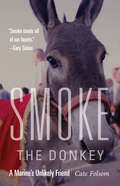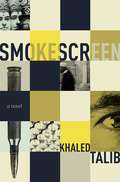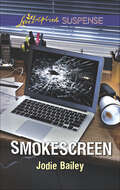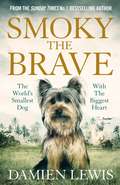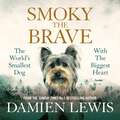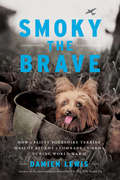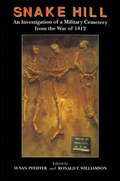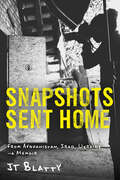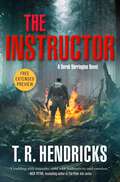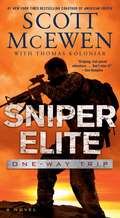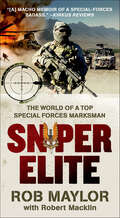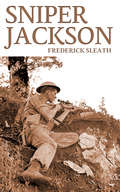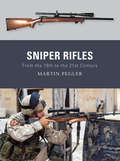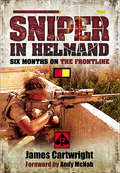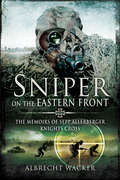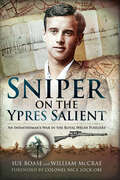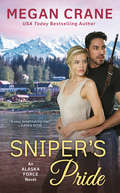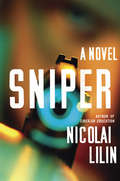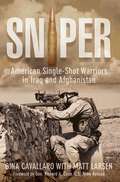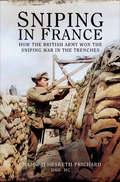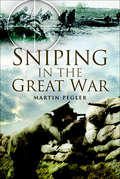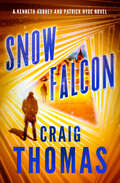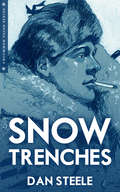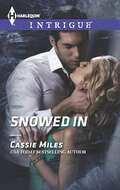- Table View
- List View
Smoke the Donkey: A Marine's Unlikely Friend
by Cate Folsom Robert R. RuarkOn a U.S. military base near Fallujah in war-torn Iraq, Col. John Folsom woke up one morning to the sound of a small, scruffy donkey tied up outside his quarters. He was charmed by this scrawny animal with a plaintive expression. Folsom and his fellow Marines took in the donkey, built him a corral and shelter, and escorted him on daily walks. One night, hanging out with the Marines as they relaxed after work, the donkey snatched someone’s lit cigarette and gobbled it up, to the laughter of all. Suddenly, the donkey had a name: Smoke. More than a conversation topic for troops connecting with families back home, Smoke served as mascot, ambassador, and battle buddy. Smoke the Donkey recounts the strong friendship between Colonel Folsom and this stray donkey and the massive challenges of reuniting Smoke with Folsom in the United States following Folsom’s retirement. After being given to a local sheik, Smoke wandered the desert before Folsom rallied an international team to take him on a convoluted journey to his new home. The team won a protracted bureaucratic battle to move Smoke from Iraq to Turkey, only to face a tougher fight getting him out of Turkey. Once in the States, Smoke became a beloved therapy animal for both children and veterans. Smoke’s story, while tinged with sadness, speaks to the enduring bond between a man and an animal, unbroken by war, distance, or red tape.
Smokescreen
by Khaled TalibAt an ancient café in Cairo, two veteran spies plot a covert mission to resolve -- once and for all -- the Israeli - Palestinian conflict. The pledge: Israel will make a major concession as part of the peace treaty. In Singapore, Jethro Westrope, a magazine journalist, stumbles onto the scene of a murder: the beautiful Niki Kishwani directs him, in her last breath, to a digital recorder, evidence that puts Jethro's life in serious danger. And, much worse, he is framed for Niki's murder. Jethro sets out to find Niki's killer and is drawn into a web of deception and intrigue involving officials from the Singaporean, Israeli, and American governments, each with a complex, competing, and potentially deadly agenda. Against this pulse-pounding backdrop, Jethro races to find answers and save himself --yet nothing is as it seems. He finds himself at the center of a political plot so diabolical and sweeping in its world implications that he is stunned to discover tomorrow's news headlines today. He is being set up not only as a murderer but as an assassin, and something much larger than his own fate is in his hands.
Smokescreen: Proof Of Innocence Person Of Interest Smokescreen
by Jodie BaileyA military man will do anything to protect the woman he never stopped loving in this romantic suspense novel of faith, danger, and second chances.When computer specialist Ashley Colson’s life is in danger, she’s rescued by the last person she ever expected to see again. Military officer Ethan Kincaid might have disappointed her once in the past, but now he’s the only person who can keep her safe. They’re under the gun to decode top secret files that can save the life of a friend who’s fallen into enemy hands. But the killers will stop at nothing to obtain get files—and Ashley. With time running out, Ashley must rely on Ethan, rediscover her faith, and put aside the past in order to fight for the future.
Smoky the Brave
by Damien LewisThe World's Smallest Dog with the World's Biggest HeartSmoky the Brave is the extraordinary, touching and true story of a heroic dog and her adoptive masters in the jungles of the Pacific War. In February 1944, as Japanese military advances threatened to engulf Australasia, a tiny, four-pound Yorkshire terrier was discovered hiding in a Japanese shell scrape amidst the thick jungles of Papua New Guinea. The GIs who discovered her presumed she had been some kind of Japanese army mascot, but it soon turned out that she understood neither commands rendered in Japanese nor English. A mystery, she was adopted by Corporal William 'Bill' Wynne, an air-crewman with the US 5th Air Force's 26th Photo Reconnaissance Squadron.Living in Bill Wynne's tent, sleeping on a piece of green felt salvaged from a card table,and sharing his rations, Smoky became the de facto mascot of the regiment. She went on to fly numerous photo-recce and air-sea rescue missions, cocooned in a soldier's pack hanging next to the machine-guns used to repel marauding Japanese fighters. She was awarded eight battle stars, surviving dozens of Japanese combat raids on Papua New Guinea, and braving a typhoon that ravaged Okinawa. After saving Wynne's life by warning of a falling shell, as their landing craft approached an enemy-held beach - a shell that killed the eight men that Wynne was standing beside - he nicknamed her the 'angel from a foxhole'. In one of her most famous exploits Smoky parachuted using a special rig designed to fit one of the world's smallest but toughest dogs.In perhaps her most heroic exploit of all, Smoky ran a cable through a seventy-foot pipe no wider in places than four inches, to enable telephone lines to be run across the recently occupied airbase of Luzon. Her efforts saved hundreds of ground-crew from being exposed to enemy bombing, preventing injury and loss of life. Amongst her many other awards,she was given the PDSA's Certificate for Animal Bravery or Devotion in 2011, a relatively new class of PDSA award.
Smoky the Brave
by Damien LewisThe World's Smallest Dog with the World's Biggest HeartSmoky the Brave is the extraordinary, touching and true story of a heroic dog and her adoptive masters in the jungles of the Pacific War. In February 1944, as Japanese military advances threatened to engulf Australasia, a tiny, four-pound Yorkshire terrier was discovered hiding in a Japanese shell scrape amidst the thick jungles of Papua New Guinea. The GIs who discovered her presumed she had been some kind of Japanese army mascot, but it soon turned out that she understood neither commands rendered in Japanese nor English. A mystery, she was adopted by Corporal William 'Bill' Wynne, an air-crewman with the US 5th Air Force's 26th Photo Reconnaissance Squadron.Living in Bill Wynne's tent, sleeping on a piece of green felt salvaged from a card table, and sharing his rations, Smoky became the de facto mascot of the regiment. She went on to fly numerous photo-recce and air-sea rescue missions, cocooned in a soldier's pack hanging next to the machine-guns used to repel marauding Japanese fighters. She was awarded eight battle stars, surviving dozens of Japanese combat raids on Papua New Guinea, and braving a typhoon that ravaged Okinawa. After saving Wynne's life by warning of a falling shell, as their landing craft approached an enemy-held beach - a shell that killed the eight men that Wynne was standing beside - he nicknamed her the 'angel from a foxhole'. In one of her most famous exploits Smoky parachuted using a special rig designed to fit one of the world's smallest but toughest dogs.In perhaps her most heroic exploit of all, Smoky ran a cable through a seventy-foot pipe no wider in places than four inches, to enable telephone lines to be run across the recently occupied airbase of Luzon. Her efforts saved hundreds of ground-crew from being exposed to enemy bombing, preventing injury and loss of life. Amongst her many other awards, she was given the PDSA's Certificate for Animal Bravery or Devotion in 2011, a relatively new class of PDSA award.(P)2018 Quercus Editions Limited
Smoky the Brave: How a Feisty Yorkshire Terrier Mascot Became a Comrade-in-Arms during World War II
by Damien LewisThe extraordinary, touching true story of Smoky, the smallest--and arguably bravest--dog of World War IIIn February 1944, as Japanese military advances threatened to overwhelm New Guinea, a tiny, four-pound Yorkshire Terrier was discovered hiding in the island's thick jungles. A total mystery as to her origins, she was adopted by US Army Air Force Corporal William "Bill" Wynne, an air-crewman in a photo reconnaissance squadron, becoming an irreplaceable lucky charm for the unit. When Smoky saved Wynne's life by barking a warning of an incoming kamikaze attack, he nicknamed her the "angel from a foxhole." Smoky's exploits continued when she jumped for the unit in a specially designed parachute and famously joined the aircrews flying daring sorties in the war-torn skies. But her most heroic feat was running a cable through a seventy-foot pipe no wider than four inches in places to enable critical communication lines to be run across an airbase which had just been seized from the enemy, saving hundreds of ground-crew from being exposed to enemy bombing.In recognition of her efforts, Smoky was awarded eight battle stars. Smoky the Brave brings to vivid life the danger and excitement of the many missions of World War II's smallest hero.
Snake Hill: An Investigation of a Military Cemetery from the War of 1812
by Susan Pfeiffer Ronald E. WilliamsonIn 1987, skeletal remains were encountered during excavation just west of Old Fort Erie, in Ontario’s Niagara Peninsula. While possession of the land had been bitterly contested in 1814, it remained virtually undeveloped and only in the 1980s, with the construction of permanent homes, did excavations yield evidence of the distant past.An international team of scholars and scientists investigated the remains and identified the individuals’ nationalities for repatriation, where appropriate. The resulting archaeological dig has proven crucial to our understanding of the siege of Fort Erie, and provided new information about military clothing, personal gear, medical science, and other details of the day-to-day life of a soldier living under battlefield conditions during the War of 1812.Snake Hill provides a detailed account of this investigation, documenting an important story of suffering and carnage, and providing the reader with a rare glimpse at life and death during the War of 1812. This book contributes significantly to our understanding of events before, during and after Fort Erie’s 1814 siege.
Snapshots Sent Home: From Afghanistan, Iraq, Ukraine—A Memoir
by Jt Blatty“… an intimate, finely-written memoir about the truths and realities shared by soldiers everywhere ... devastatingly moving ...”—Jon Lee Anderson, staff writer, The New Yorker; author of Che Guevara and The Fall of BaghdadUS combat veteran and photographer JT Blatty journeyed to Ukraine in 2018 to capture oral history and portraits of Donbas volunteer soldiers. In frontline bunkers and Kyiv flats, her story began to blend with theirs in a universal bond of combat veterans, compelling her to stay as a new war began.“… powerful, engaging narrative … a sense of place and people that is usually only arrived at by being there ..."—Alexa Dilworth, independent writer and editor; former publishing director and senior editor at the Center for Documentary Studies at Duke University
Sneak Peek for The Instructor: A Derek Harrington Novel
by T. R. HendricksDive into The Instructor, former Army intelligence officer T. R. Hendricks' fast paced, action-packed debut thriller that's Jack Reacher meets Survivorman, the first novel in the Derek Harrington series!“Packed with action, tension, and humanity, The Instructor delivers.”—Mark Greaney, #1 New York Times bestselling author of Burner, a Gray Man NovelDerek Harrington, retired Marine Force Recon and SERE instructor, is barely scraping by teaching the basics of wilderness survival. His fledgling bushcraft school is on the cusp of going out of business and expenses are piling up fast. His only true mission these days? To get his ailing father into a full care facility and to support his ex-wife and their son.When one of his students presents him with an opportunity too good to be true—$20,000 to instruct a private group for 30 days in upstate New York—Derek reluctantly takes the job, despite his reservations about the group's insistence on anonymity. But it isn't long before the training takes an unexpected turn—and a new offer is made.Reaching out to an FBI contact to sound his concerns, Derek soon finds himself in deep cover, deep in the woods, embroiled with a fringe group led by a charismatic leader who will stop at nothing to get what he wants. When what he wants becomes Derek's head, the teacher is pitted against his students as Derek races against time to stop what could very well be the first attack of a domestic terrorist cell.“A pulse-pounding thriller. . . Hendricks delivers on all cylinders!”—Simon Gervais, former RCMP counterterrorism officer and bestselling author of The Last ProtectorAt the Publisher's request, this title is being sold without Digital Rights Management Software (DRM) applied.
Sniper (Seals #10)
by Steve MackenzieIn the deadly world of modern warfare, the art of combat is taken to its awesome limits. Only one fighting unit has the skills and ruthlessness to handle all this power, making every corner of the globe its field of fire; using with chilling efficiency every method of infiltration, demolition, deception, and destruction this side of hell. They're Navy. Those who know about them speak in awed whispers of the men they call the... SEALS.<P> What started as a secret test was now a Navy nightmare! The project: probe the ESP communication capabilities of Tynan's troops. The result: short-tempered sailors who'd rather be fighting than telling fortunes. Except for one - who thinks he can actually see the future... and believes he must commit an atrocity to save the world. Mystic or madman, Tynan must stop him - whatever the cost.
Sniper Elite: A Novel (Sniper Elite #1)
by Thomas Koloniar Scott McEwenFrom the coauthor of the #1 New York Times bestseller American Sniper—the critically acclaimed memoir of SEAL sniper Chris Kyle—this &“inspired by true events&” thriller follows one of America&’s most lethal marksmen as he leads the rescue of a downed female Special Ops pilot.ONE TEAM. ONE SHOT. ONE WAY. In direct defiance of the president&’s orders, Navy Master Chief Gil Shannon, one of America&’s most lethal SEAL snipers, launches his own bold mission comprised of SEAL Team Six and Delta Force fighters to free a female helicopter pilot being held and brutally mistreated by Taliban insurgents in Afghanistan. The president fears a botched rescue would be a foreign policy disaster—and the end of his term. But once the special ops community learns that one of their own has been taken hostage, there is no executive order strong enough to stop them from going in—whatever the risks.
Sniper Elite: The World of a Top Special Forces Marksman
by Robert Macklin Rob MaylorA gritty, no-holds-barred behind-the-scenes memoir of life as one of the world's top snipersIn Sniper Elite, Rob Maylor takes readers inside the closed world of the elite Special Forces sniper, detailing Maylor's dedication to the dark art of sniping and touching on the history of the great snipers who came before him. As one of Australia's most highly trained and successful combat marksmen, he tells the story of his years on the front lines, from his early service with the Royal Marines in Northern Ireland, to action in Iraq and most recently in Afghanistan where he was involved in some of the heaviest fighting in the conflict. He also chronicles his near-death experience in a Blackhawk helicopter that crashed off Fiji, killing two of his friends, and how he would walk for hours, sometimes days, through hostile country until he found the right position. Then, when the moment was right, he aimed, and with absolute precision, put the bullet just where it was going to have the most effect.Filled with dark humor and the almost religious sense of brotherhood within such an exclusive group of warriors, this is an explosive and revealing combat memoir—and an inside look at the shadowy world of the modern sniper.
Sniper Jackson: A First Novel
by Frederick SleathSniper Jackson, first published in 1919, is a first-hand account of trench fighting in Belgium and France in World War One. The book, although somewhat fictionalized, details the activities of a group of British soldiers facing the Germans across a deadly No Man's Land. One soldier, "Sniper Jackson", is a keen marksman and his role and importance in the skirmishes are well-described, a rarely described aspect of most books on World War One. The book also details the close-knit camaraderie among the soldiers, a factor which helped them survive the miserable conditions of the trenches and the dangers they faced from artillery attacks and enemy advances.
Sniper Rifles: From The 19th to the 21st Century
by Martin PeglerThe sniper has lurked in the shadows of warfare for more than two centuries. In that time, snipers have gone from being seen as little more than paid assassins to being the most highly trained of all infantrymen, and they are an invaluable asset on any modern battlefield. Two hundred years of development and innovation divides the Napoleonic rifleman, whose muzzle-loader was capable of extreme-range shots of 300 yards, from the modern sniper whose high-precision .50 and . 338 calibre rifles can achieve kills at well over a mile.
Sniper in Helmand: Six Months On The Frontline
by James CartwrightFew soldiers are deemed good enough to be selected and trained as snipers and even fewer qualify. As a result, snipers are regarded as the elite of their units and their skills command the ungrudging respect of their fellows - and the enemy. The Author is one such man who recently served a full tour of duty with 1st Battalion the Royal Anglian Regiment in Helmand Province, Afghanistan. James describes the highs and lows of almost daily front line action experienced by our soldiers deployed on active service in arguably the most dangerous area of the world. As part of the Battle Groups crack Mobile Operations Group, Jamess mission was to liquidate as many Taliban as possible. The reader experiences sniper tactics and actions, whether in ambush or quick pre-planned strikes, amid the ever present lethal danger of IEDs. His book, the first to be written by a trained sniper in Afghanistan, reveals the psychological pressures and awesome life-and-death responsibility of his role and, in particular, the deadly cat-and-mouse games with the enemy snipers intent on their own kills. These involved the clinical killing of targets at ranges of 1,000 meters or greater. Sniper in Helmand is a thrilling action-packed, yet very human, account of both front line service in the intense Afghanistan war and first-hand sniper action. Andy McNab inspired James to join the army and has written a moving foreword.
Sniper on the Eastern Front: The Memoirs of Sepp Allerberger, Knight's Cross
by Albrecht WackerJosef Sepp Allerberger was the second most successful sniper of the German Wehrmacht and one of the few private soldiers to be honoured with the award of the Knights Cross.An Austrian conscript, after qualifying as a machine gunner he was drafted to the southern sector of the Russian Front in July 1942. Wounded at Voroshilovsk, he experimented with a Russian sniper-rifle while convalescing and so impressed his superiors with his proficiency that he was returned to the front on his regiments only sniper specialist.In this sometimes harrowing memoir, Allerberger provides an excellent introduction to the commitment in fieldcraft, discipline and routine required of the sniper, a man apart. There was no place for chivalry on the Russian Front. Away from the film cameras, no prisoner survived long after surrendering. Russian snipers had used the illegal explosive bullet since 1941, and Hitler eventually authorised its issue in 1944. The result was a battlefield of horror.Allerberger was a cold-blooded killer, but few will find a place in their hearts for the soldiers of the Red Army against whom he fought.
Sniper on the Ypres Salient: An Infantryman's War In The Royal Welsh Fusiliers
by Sue Boase William McCraeJust after midnight on 22 April 1916 on the Western Front, a sergeant from the 15th (1st London) Royal Welsh Fusiliers came sliding and stumbling along the dark, mud-filled trench towards the four men, huddled together and soaked-through, in the shallow dugout. He was clutching his postbag in which there were four parcels for one of them, William McCrae, whose twentieth birthday fell on this day. A hand-written account by William, my grandfather, was found in my mother’s papers, long after his death. This book describes a year of his time fighting in the First World War, from December 1915 to December 1916. Two months after his birthday, he was marching towards the Somme, where he was to act as a runner during the key Welsh engagement in the Battle of Mametz Wood. Later, he went on to volunteer and train as a sniper. He continued in this role for over a year, becoming a lance corporal in the 38th Divisional Sniping Company while fighting on the Ypres Salient. His words emphasise the key role snipers played in the collecting of intelligence about the enemy, through close observation and careful reporting. His account stops abruptly in mid-sentence, just at the point where he indicates he is about to reveal more to us about ‘a new, interesting part of the line to be manned by us Snipers’. Piecing together clues from his sketches, maps and photos, and this book paints a picture of Williams’ time during the rest of the war. In 1917 he returned to England to train as a temporary officer in the 18th Officer Cadet Battalion at Prior Park, Bath. He came back to the Western Front as a 2nd Lieutenant in the Duke of Wellington’s (West Riding) Regiment, where he was seconded to the 1/5 Lancashire Fusiliers until the end of the war. During this time, it is likely that his interest and experience as a sniper continued, with evidence that he may have taught at one of the Sniping Schools set up across France.
Sniper's Pride (An Alaska Force Novel #2)
by Megan CraneReturn to Alaska's Grizzly Harbor where danger strikes with arctic precision and love thaws the coldest hearts in the newest romantic suspense from the USA Today bestselling author of SEAL's Honor. After Mariah McKenna lands in the hospital with a life-threatening anaphylactic reaction she knows she didn’t cause, she realizes her cheating, vindictive husband would rather have a dead wife than a divorce. Afraid that he will succeed in killing her next time, Mariah goes to Grizzly Harbor to hire one of the Alaska Force special operatives to help her survive long enough to finally live a little. Griffin Cisneros traded in a comfortable future for boot camp, where he learned the virtue of patience and focus—skills that served him well as a Marine sniper. Few things get to him these days, but something about Mariah’s mix of toughness and vulnerability gets right under his skin. Until it’s clear she’s the one thing in the world that might melt the ice in stoic, reserved Griffin, whether he likes it or not. If he can just keep her alive...
Sniper: A Novel
by Nicolai LilinPoised to stand among the great war novels, the harrowing chronicle of a sniper during the Chechen War. "The saboteurs? Holy Christ, what happened? What did you do to deserve that?" a fellow soldier responds when he hears that Nicolai Lilin has been assigned to an unconventional, ultra-high-risk paramilitary unit of the Russian army. Also nicknamed the "para-bats" for the black parachutes that dropped them behind enemy lines at night, Lilin and his fellow "saboteurs" soon find themselves fighting Islamic insurgents armed with American weaponry in the breakaway province of Chechnya. In vivid, harrowing detail, Lilin relays how, under the mind-bending dangers of heavy fire, on unknown terrain, in unpredictable small villages, the only goal is survival. Under the leadership of corrupt generals profiting from the war, his unit develops a camaraderie that is their best hope for staying alive--and staying human. Ultimately, the return to the bland normality of an impersonal society at "peace" might be the hardest struggle of all. Writing with unhindered directness and power, Lilin combines his own experiences as a sniper in Chechnya together with the stories of those he fought beside to forge an autobiographical novel unique in the literature of war. A bestseller in Europe, this novel will remain an unforgettable account of one of the ugliest conflicts of our time.
Sniper: American Single-Shot Warriors in Iraq and Afghanistan
by Matt Larsen Gina CavallaroHeart-pounding real-life tales from the military&’s most experienced snipers, the best of the best snipers in action today. Gunfights, long distance shots, stalking, and more.
Sniping in France: How the British Army Won the Sniping War in the Trenches
by H. Hesketh-PrichardAvailable for the first time in years, this is a new edition of the classic account by the adventurer and big game hunter who developed and ran the British Army sniping programme in the First World War. When the war started in 1914, Germany's edge in the sniping duel on the Western Front cost thousands of British casualties. Sniping in France explains the methods Hesketh-Prichard used to reverse the situation and help win the sniping war. A glossary of terms and a photograph of the author have been added.
Sniping in the Great War
by Martin PeglerA military history analyzing the evolution of sniper warfare during WWI by the firearms expert and author of Eastern Front Sniper. From the sharpshooters of the American Civil War to Navy SEAL Chris Kyle, military snipers are legendary for their marksmanship and effectiveness in battle. The specialized role of the sniper developed among the ranks of the British Army over the course of World War I. As Martin Pegler shows in this wide-ranging study, the technique of sniping adapted rapidly to the conditions of static warfare that prevailed through much of the conflict. Pegler&’s account follows the development of sniping from the early battles of 1914, through the trench fighting and the attritional offensives of the middle years, to the renewed open warfare of 1918. Focusing on the British and German sniping war on the western front, Pegler also looks at how snipers operated at Gallipoli, Salonika, and on the Eastern Front. He also covers sniper training, fieldcraft, and counter-sniping measures in detail. Sniping in the Great War includes a full reference section detailing the sniping rifles of the period and assessing their effectiveness in combat. Also featured are vivid memoirs and eyewitness accounts that offer insight into the lethal skill of Great War snipers and their deadly trade.
Snow Falcon (The Kenneth Aubrey & Patrick Hyde Series)
by Craig ThomasNew York Times–Bestselling Author: A suddenly uninhabited Finnish village sparks a mystery—and foreshadows an epic threat . . . An international agreement to slow the arms race is in the works, but not everyone is happy about it. The KGB and MI6, with CIA support, begin to take action as suspicions about a mutiny within the Red Army swirl. Under Kenneth Aubrey&’s direction, Snow Falcon will be a high-risk mission to investigate strange developments on the frozen Finnish border, while Russian intelligence officers embark on the dangerous task of identifying plotters within the military. And if they don&’t succeed, the consequences could be dire for multiple nations . . . &“Complex, brisk . . . Solid.&” —Kirkus Reviews &“When it comes to keeping the story moving and stoking up the excitement, Mr. Thomas knows his business.&” —The New York Times
Snow Trenches
by Dan SteeleSnow Trenches, first published in 1931, is author Dan Steele's novel-like account of his adventures in World War One as part of the North Russian American Expeditionary Forces, fighting communist Bolsheviks in the far north of Russia near the Dvina River and the city of Archangel (now Arkhangelsk). The troops, poorly provisioned, and in cold, unforgiving terrain, are a little known chapter in American military history; their ill-defined mission was doomed from the start to failure. Snow Trenches paints a picture of the soldiers struggling to survive in a strange, bleak landscape against a determined foe. Along the way, the main character meets and falls in love with a young Russian woman, and together they fight to survive in this remote conflict.
Snowed In
by Cassie MilesA small-town innkeeper's life is transformed by a sexy army ranger in USA TODAY bestselling author Cassie Miles's SNOWED IN Rescuing a beautiful woman from four armed men wasn't how Blake Randall planned to spend his army leave. But as chief security detail at his best friend's wedding, the ranger's mission is just beginning. A blizzard has cut off Sarah Bentley's Colorado B and B from the outside world, trapping them with a killer. Snowed in with the rugged stranger who already saved her life once, Sarah has no choice but to trust Blake. As passion ignites, she realizes he's more than a strong shoulder to lean on. With danger escalating, it's time to listen to what her heart's telling her: with Blake by her side, they can survive anything....
